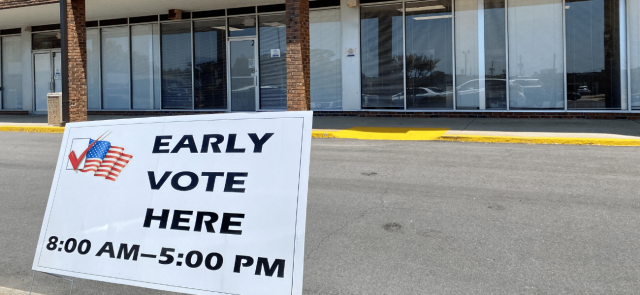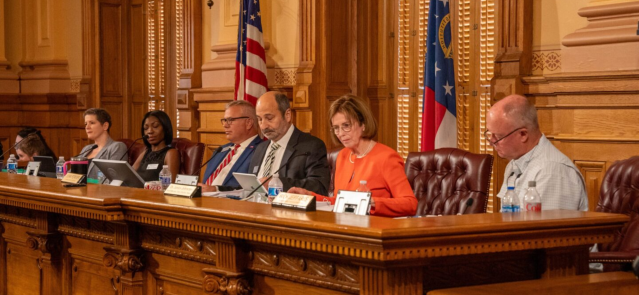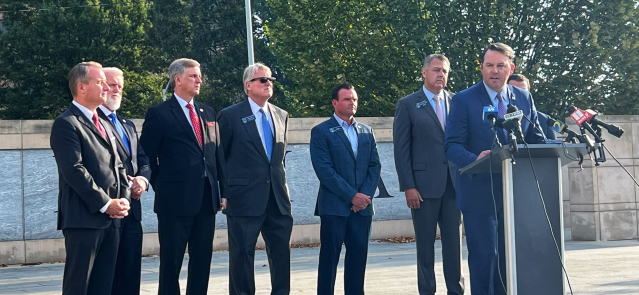Stay ahead of the curve as a political insider with deep policy analysis, daily briefings and policy-shaping tools.
Request a DemoGeorgia leaves millions in federal aid for older foster children ‘on the table’

Wellroot Family Services facility in Decatur, GA. (Credit: Wellroot Family Services)
Part 2 of a recurring series on the state’s foster care system and those aging out of it. Read Part 1 here.
ATLANTA — Young people aging out of Georgia’s foster care system are missing out on millions of dollars in federal money earmarked for their extended care because the state has declined to participate in a program that partially reimburses the cost of that care, child welfare advocates say.
Children in Georgia are allowed to stay in the state’s foster care system until the age of 21 and critics say those over age 18 could be getting far more resources and support if the state were taking advantage of Title IV-E, a federal foster care grant program that in FY2022 had a budget of $5.83 billion to dole out.
There were 629 young people in Georgia’s foster care system over the age of 18 as of Jan. 3, according to Kylie Winton, a spokesperson for the Georgia Department of Human Services. Black children account for a disproportionate number of those children. In 2021, Blacks accounted for 34% of the state’s population but 43% of the foster care population, according to the Annie E. Casey Foundation.
According to the Children’s Bureau, an office of the Administration for Children and Families, which is part of the U.S. Department of Health and Human Services, the Title IV-E reimbursement plan has been an option for states since 2008, but as of February 2023, only 34 states and the District of Columbia and Puerto Rico were “approved to operate a foster care program serving young people over age 18.” Georgia is not one of those states.
“We’ve always used state funds to offer an extended foster care program for youth ages 18 to 21,” Winton told State Affairs in a written statement. “We considered amending our Title IV-E plan to include reimbursement for extended foster care in 2019 but ultimately decided not to because of requirements mandated by those on the federal level. Implementing those requirements would create new expenses we’d have to use state funds to cover. We have the option to revisit this in the future if circumstances change.”
Meanwhile, Georgia’s General Fund reserves — better known as surplus — exceeded $16 billion at the end of FY 2023, according to the Georgia Budget and Policy Institute.
Other states participating in the Title IV-E program are receiving millions of dollars in reimbursements for their programs for young people aging out of the system, enabling them to provide more services and resources to youth, Todd Lloyd, senior policy associate with the Annie E. Casey Foundation, told State Affairs.
“Georgia’s decision not to participate is leaving millions of dollars on the table,” Lloyd said.
Child well-being consultant Eshontee Rowe agrees. She recently met with officials in foster care in Florida where she said “they have Title IV-E funding and they’re able to service a lot more kids in their state not only from the federal dollars but from outside community partners that help invest in the young people. We’re trying in Georgia to get along those lines as well.”
Rowe spent time in Georgia’s foster care system and understands first-hand the challenges young people who were never adopted or received guardianship face leaving the system and living on their own.
“The young people who need the services aren’t able to get the funding they need to transition properly,” Rowe said. “They [state foster care officials] don’t want to talk about why they don’t want to do it.”
While Georgia is among the top five states in the nation providing life skills training for young people leaving foster care, fewer young people are opting to stay in extended care.
Around 700 young adults age out of Georgia’s foster care system each year. After the pandemic, foster care officials are reporting fewer young people are opting to stay in foster care. Overall numbers dropped when the pandemic extension of care ended. The extension of care enabled young adults to stay beyond the age of 21.
Many of those young people wind up struggling to find work or finish school. Nationally, between 47% to 69% of those who went through the foster care system are unemployed as adults, according to betterhelp.com.
“Those kids face a lot of challenges. These kids don’t have any type of connections,,” said Allison Ashe, chief executive officer of Wellroot Family Services, which provides transitional living services in Georgia for young people aging out of the system. “They’re really lacking in the soft skills to be able to get their first job. While they were in [foster care] they weren’t even learning how to cook or how to shake a hand or how to look somebody in the eye or even have a conversation with somebody.”
Those who have access and take advantage of resources have a far better chance of succeeding in life and staying out of the judicial system, experts say. More Georgia foster youth have spent time in jail than their peers in the rest of the country.
In 2021, some 4 in 10, or 41%, of Georgia youth in foster care had been incarcerated at some point by the time they were 21-years-old compared to 35% nationally, according to the Annie E. Casey Foundation’s Fostering Youth Transitions 2023 study.
Others like e Tiffani McLean-Campbell have experienced worse. The young woman who is in extended care in Georgia recently testified before the U.S. Senate Human Rights subcommittee in Atlanta. “I experienced abuse, medical neglect, educational neglect and was even sexually assaulted and trafficked,” McLean-Campbell told the subcommittee, chaired by U.S. Sen. Jon Ossoff from Georgia.
While McLean-Campbell’s story may be an extreme case, others like Rowe managed to navigate the system to their advantage. Rowe, for example, received money for housing and became the first in her family to graduate from college with the help of resources she used while in the foster care system.
“I always tell [young people in foster care] to stay connected,” Rowe said. “It’s sad that I have to say it like this but the way I phrase it to them is like ‘Look, at 18 you get all of your reparations. Get your reparations for all the crap you went through. Take advantage of all the resources. Get everything you can. I’ve been able to obtain apartments. I’ve been able to get help with downpayment assistance on cars and just different funding opportunities because I decided to stay connected.”
Many more children are entering foster care as adolescents or teenagers , Rowe said And that’s the group of children in foster care who have typically been overlooked, she added. That’s changing, however. “I think it’s great now that policymakers and stakeholders are really looking at that transition age youth,” said Rowe.
Georgia’s decision not to participate in the Title IV-E program comes at a time when the federal government has issued a lot more money to help young people in foster care, with the vast amount of increase coming during the pandemic.
The normal federal annual allocation for foster care nationwide was $143 million, Lloyd said. That money is distributed through the John H. Chafee Foster Care Program for Successful Transition to Adulthood. The Chafee money was increased by an additional $400 million during the pandemic. And in an unprecedented move, the federal government urged states to find and help former foster care youth during the pandemic, going as far as to issue checks to young people until the age of 26.
Nearly a million young people in foster care between the ages of 14 and 26 were eligible for the money to help with basic needs such as housing and finishing high school, college or vocational training. Some 22,000 of those were young people in Georgia, Lloyd added.
“That’s a lot of young people and this was an unprecedented move by the federal government to provide resources to young people aging out of foster care,” Lloyd said.“ Did Georgia utilize, maximize [the stimulus money]? Did they spend them all? Because that’s another example where they could be leaving literally millions of dollars on the table.
“I’m concerned because of the delivery of services. You had unprecedented amounts of money flowing to states in a stimulus package that gave money specifically for older foster kids,” Lloyd added. “I was very disappointed because there were states that we were working closely with that did a great job. For example, South Carolina spent every dime and they were ready for more. And there were other states that hadn’t spent a single dime.”
And states like Georgia that never applied for the Title IV-E plan or, it appears, has not fully spent its Chafee stimulus money.
Have questions? Contact Tammy Joyner on X @lvjoyner or at [email protected].
And subscribe to State Affairs so you do not miss an update.
X @StateAffairsGA
Facebook @StateAffairsGA
Instagram @StateAffairsGA
LinkedIn @StateAffairs
Election administrators ‘in limbo’ over new voting rules, top official says
If you plan to hand-deliver your absentee ballot to your local election office this year, you’ll have to show identification and sign a form stating whose ballot you’re dropping off, under a new rule recently passed by the State Election Board. If you fail to show your ID or don’t complete the form, your ballot …
Weekend Read: State Election Board marks its 60th year mired in controversy. Here’s what happened.
In 1964, Georgia lawmakers retooled the state’s election process to create a “one person, one vote” system after the U.S. Supreme Court outlawed the “county unit system” that held sway over Peach State politics for nearly half a century. Until then, politicians hoping to win primaries in Georgia had to capture entire counties, not just …
State lawmakers: Atlanta, give detention center to Fulton to fix problem-plagued jail
Atlanta city officials need to give the Atlanta Detention Center to Fulton County to ease overcrowding in the county’s violence-prone jail, a bipartisan panel of state lawmakers said in its final report, released Friday. “A big part of the solution is that the City of Atlanta needs to turn over the Atlanta Detention Center to …
Georgia plays a prominent, although louder, role at this convention, too
As the second of the two biggest political party events wraps up this evening in Chicago with Vice President Kamala Harris accepting the Democratic presidential nomination, all eyes in Georgia are turning to the grand finale — the Nov. 5 election. “We are all energized because we know we are bringing back hope for our …




